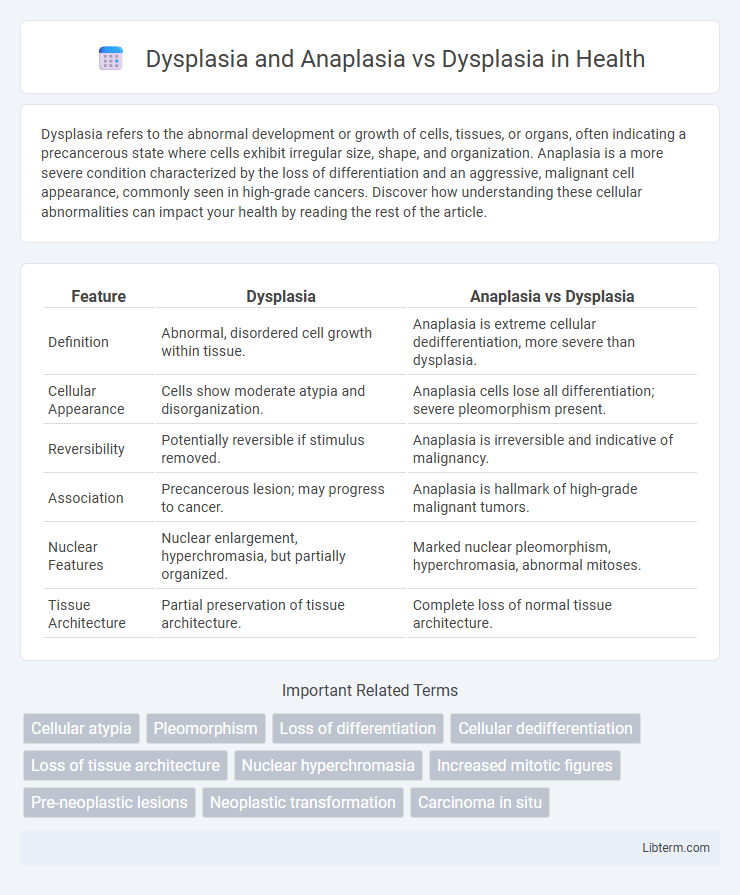Dysplasia refers to the abnormal development or growth of cells, tissues, or organs, often indicating a precancerous state where cells exhibit irregular size, shape, and organization. Anaplasia is a more severe condition characterized by the loss of differentiation and an aggressive, malignant cell appearance, commonly seen in high-grade cancers. Discover how understanding these cellular abnormalities can impact your health by reading the rest of the article.
Table of Comparison
| Feature | Dysplasia | Anaplasia vs Dysplasia |
|---|---|---|
| Definition | Abnormal, disordered cell growth within tissue. | Anaplasia is extreme cellular dedifferentiation, more severe than dysplasia. |
| Cellular Appearance | Cells show moderate atypia and disorganization. | Anaplasia cells lose all differentiation; severe pleomorphism present. |
| Reversibility | Potentially reversible if stimulus removed. | Anaplasia is irreversible and indicative of malignancy. |
| Association | Precancerous lesion; may progress to cancer. | Anaplasia is hallmark of high-grade malignant tumors. |
| Nuclear Features | Nuclear enlargement, hyperchromasia, but partially organized. | Marked nuclear pleomorphism, hyperchromasia, abnormal mitoses. |
| Tissue Architecture | Partial preservation of tissue architecture. | Complete loss of normal tissue architecture. |
Introduction to Dysplasia and Anaplasia
Dysplasia represents abnormal cellular development characterized by disorganized growth and altered cell morphology, frequently serving as a precancerous condition. Anaplasia involves a more severe loss of differentiation and cellular organization, often indicating malignancy and aggressive tumor behavior. These pathological changes are critical in histopathology for distinguishing between reversible premalignant lesions and irreversible malignant transformations.
Defining Dysplasia: Key Features
Dysplasia is characterized by abnormal cellular growth and organization within a tissue, often marked by variability in cell size, shape, and nuclear appearance, reflecting disordered maturation. Dysplasia differs from anaplasia, which shows more severe cellular dedifferentiation, loss of normal structure, and increased malignancy potential. Key features of dysplasia include hyperchromatic nuclei, increased mitotic figures, and disturbed tissue architecture without invasion beyond the basement membrane.
Understanding Anaplasia: Hallmarks and Characteristics
Anaplasia is characterized by a loss of cellular differentiation, marked nuclear pleomorphism, high mitotic activity, and abnormal mitotic figures, distinguishing it from dysplasia which typically shows disordered but recognizable cellular architecture. Hallmarks of anaplasia include increased nuclear-cytoplasmic ratio, hyperchromatic nuclei, and prominent nucleoli, reflecting aggressive tumor behavior and malignancy. Understanding these features is crucial for accurate pathological diagnosis and prognosis assessment in oncology.
Dysplasia vs Anaplasia: Core Differences
Dysplasia refers to abnormal cellular growth characterized by disorganized but still recognizable tissue architecture, often considered a precancerous condition. Anaplasia indicates a more severe loss of differentiation, with cells exhibiting marked pleomorphism, high mitotic activity, and aggressive malignant behavior. Core differences between dysplasia and anaplasia lie in the degree of cellular differentiation, with dysplasia showing partial organization and anaplasia demonstrating complete loss of normal cell structure and function.
Causes and Risk Factors of Dysplasia
Dysplasia arises primarily from persistent irritation or chronic inflammation, with common causes including human papillomavirus (HPV) infection, smoking, and exposure to carcinogens like asbestos or radiation. Genetic mutations and immunosuppression also increase susceptibility to cellular abnormalities that lead to dysplastic changes. Unlike anaplasia, which denotes complete loss of differentiation often seen in aggressive cancers, dysplasia represents early disordered growth often reversible if underlying causes are addressed promptly.
Clinical Implications of Anaplasia
Anaplasia indicates a higher degree of cellular atypia and loss of differentiation compared to dysplasia, often correlating with aggressive malignancies and poor prognosis. Clinically, anaplasia is associated with invasive tumor behavior, increased metastatic potential, and resistance to conventional therapies, necessitating more intensive treatment strategies. Monitoring anaplastic changes is critical for early detection of malignant transformation and guiding prognosis in cancer management.
Histopathological Comparison: Dysplasia and Anaplasia
Dysplasia in histopathology is characterized by disorganized but recognizable cellular architecture, nuclear pleomorphism, and increased mitotic activity confined to the epithelium, indicating a premalignant state. Anaplasia exhibits a loss of cellular differentiation, marked nuclear atypia, high mitotic rate, and abnormal mitoses, reflecting malignant transformation and poor prognosis. The key distinction lies in the preservation of tissue architecture in dysplasia versus the marked architectural disruption and cellular anaplasia observed in malignant tumors.
Prognostic Value: Dysplasia vs Anaplasia
Dysplasia serves as an early indicator of abnormal cell growth with potential for progression to malignancy, offering significant prognostic value by signaling premalignant changes that may be reversible or controllable. Anaplasia represents a higher degree of cellular dedifferentiation and loss of normal morphology, correlating with aggressive tumor behavior, poor differentiation, and worse clinical outcomes. The presence of anaplasia typically denotes a more advanced, less favorable prognosis compared to dysplasia, which highlights its critical role in cancer staging and therapeutic decision-making.
Management and Treatment Strategies
Management of dysplasia primarily involves regular monitoring and targeted interventions such as surgical excision or ablation to prevent progression to malignancy, with treatment intensity depending on the grade and location of the dysplastic lesion. Anaplasia, indicating a loss of differentiation often seen in aggressive cancers, requires more comprehensive treatment strategies including multimodal approaches like surgery, chemotherapy, and radiotherapy tailored to tumor type and stage. Early detection and accurate histopathological assessment guide effective treatment planning, reducing the risk of cancer development in dysplasia and improving prognostic outcomes in anaplastic malignancies.
Conclusion: Clinical Significance in Diagnosis
Dysplasia represents abnormal cell growth with potential for progression to malignancy, serving as a critical precursor in cancer diagnosis, while anaplasia indicates a loss of cellular differentiation, typically observed in aggressive, high-grade tumors. Identifying dysplasia aids early intervention and monitoring, whereas detection of anaplasia often signifies advanced disease requiring more intensive treatment. Clinically, distinguishing between dysplasia and anaplasia is vital for prognosis, therapeutic decisions, and patient management in oncology.
Dysplasia and Anaplasia Infographic

 libterm.com
libterm.com